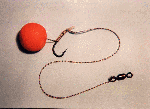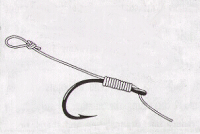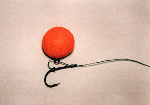Braids come in many styles and colours and all have different properies when in use. They are low diameter and very srong.
Some carp specialists beleive that braids offer superior presentation due to the way they allow hookbaits to move, if disturbed by a feeding carp. This allowed movement will make them behave like loose offerings so not alarming the fish.
Braids are very resistant to abraision wich is an advantage if fishing over steep, sharp gravel bars.
Good strong knots can be tied easily with braid. Sections of the rig can also be stiffened with super glue or Hawser.
 Click for bigger picture |
Stiff links can be made from either Mono nylon or one of the many materials available in the tackle shops.
Stiff links contradict what some say about supple links because they do not move naturally when disturbed. They do offer one big advantage though. Once in the mouth of a carp they are very hard to eject.
 Click for bigger picture |
|
Combi links are a combination of supple and stiff rigs.
Supple sections of the link can act as a hinge, allowing some movement of the hookbait. The stiff sections can make the bait very hard to eject.
You can make your own combi links by tying a stiff mono like Amnesia to a soft braid, but attaching the two together can be tricky as stiff mono nylon is hard to knot.
The best way to tie your on is to buy one of the materials available in shops. These consist of an inner and outer core. The outer core can be stripped off to expose the supple inner core.
|
Click for bigger picture |
|
Multi strand hooklinks are made up of hundreds of extremely fine strands.
The advantage of multi strands is that they are almost un-detectable due to the strands seperating when squashed. A good link for fine presentation although it can pick up debris between the strands after some use, making the link prone to tangles.
|
|
You can tie hooklinks from just mono. Choosing a lower breaking strain will make a supple link and a higher breaking strain will produce a stiffer link.
Well worth a try if your venue has seen heavy use of braids.It is also the cheapest way of tying your own links.
Hook patterns
There are many different ways of tying hooks and hairs. Try to keep them simple unless you are fishing hard waters where there is a need to use more advanced patterns. Remember the more elements there are to the rig, the more there is to go wrong.
This is the easiest way to tie your hook. The not formed is extremely strong and it also makes the hair
1. Take a length of hooklink material. Tie a small loop in one end for the hair.
 |
|
2. Pass the other end of the link through the eye of the hook from the bend side of the hook.
 |
|
3. leave enough of the loop end to form the hair. Next whip the long end around the hook shank at least 6 times and pass it back through the eye from the same direction.
 |
|
 |
|
The D rig allows the bait to move freely but it is still firmly attached to the hook shank. Once in the mouth the rig aligns the hook with the carps bottom lip making it hard to eject.
|
|
|
|

Website created by Whizwebs
Comments and suggestions welcomed



